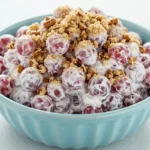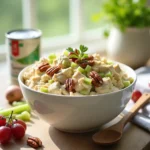Introduction
A cookie cake is a fun way to combine the taste of a classic cookie with the look of a standard cake. It offers the crisp edges found in fresh cookies and the soft center you’d expect from a cake. Many people enjoy this style of dessert because it’s simple, easy to share, and feels special enough for birthdays or celebrations. You can customize it with chocolate chips, colorful sprinkles, or any other toppings you like.
Baking a cookie cake at home tastes so much better than grabbing a pre-made version from a store. There’s something exciting about mixing the dough yourself and smelling the sweet aroma as it bakes. Plus, you control the ingredients, so you can adjust the sugar level, choose the type of chocolate chips, or try different flavors. This way, you can create a chewy and satisfying treat that suits your preferences perfectly.
In this guide, we’ll explore the steps for a homemade cookie cake recipe, share tips for achieving a soft center with crisp edges, and suggest easy variations. Whether you’re new to baking or seeking a fresh dessert idea, a cookie cake is an excellent choice. Let’s begin by highlighting why this dessert is worth trying.
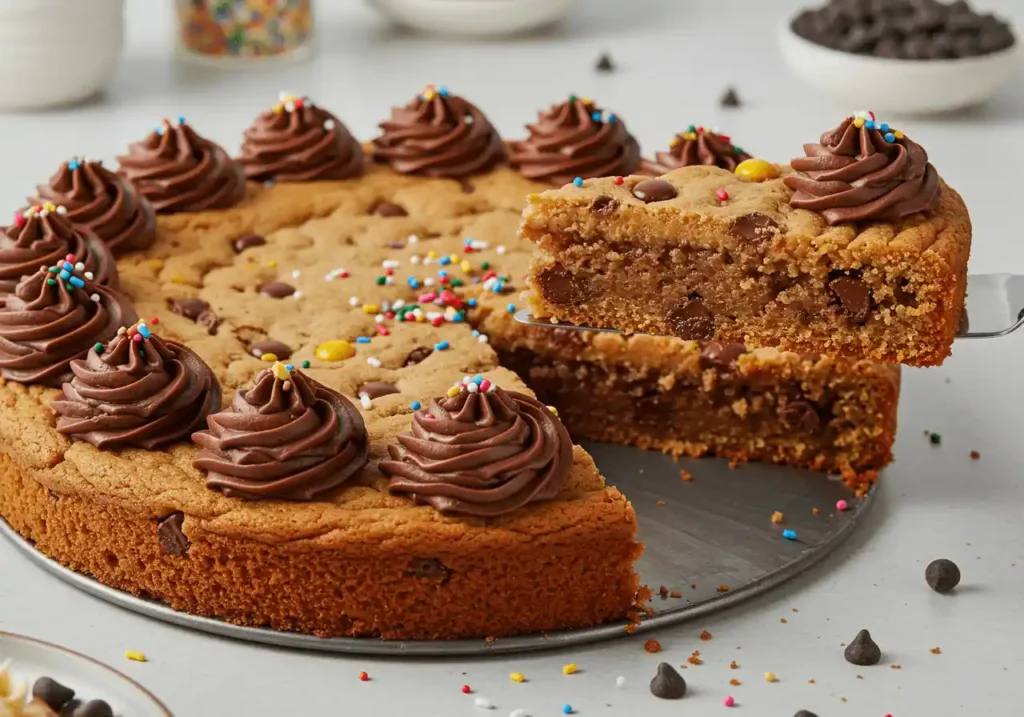
Table of Contents
Key Benefits
A cookie cake combines the fun of a big cookie with the familiar shape of a cake. This dessert is simple to prepare, and the finished product looks festive on any table. Here are the main advantages:
- Easy Preparation: You can make the dough like a basic cookie recipe, then press it into a single cake pan. This approach saves time compared to crafting a multi-layer cake.
- Fewer Tools: All you need is a bowl, a mixer, and a round cake pan—or a springform pan—to shape and bake your cookie cake. Clean-up is quick because there’s only one pan.
- Chewy and Crisp: Many people enjoy a contrast in textures. A cookie cake delivers soft, chewy goodness in the center with crisp edges around the pan.
- Endless Flavor Choices: You can add chocolate chips, rainbow sprinkles, or top it with frosting and extra candy. Each option changes its look and taste.
- Celebration-Ready: This dessert can be a birthday cake alternative or a sweet surprise at a family gathering. You can frost the outer edges or pipe decorations to personalize it.
- Tastes Better Homemade: Making it yourself puts you in control of sweetness, chocolate chip amounts, and other ingredients. This ensures the perfect cookie cake for your tastes.
Ingredients
When preparing a cookie cake, it’s helpful to gather all items first. This basic list ensures you have everything needed to create a chewy, crowd-pleasing dessert. Feel free to adjust based on your favorite flavors or dietary preferences.
- All-Purpose Flour (2 ¼ cups)
This is the usual choice for a homemade cookie cake. It balances structure with softness. If you switch to cake flour, expect a lighter cookie texture, but remember that standard all-purpose flour typically gives a classic chewy cookie. - Baking Soda (1 teaspoon)
Baking soda helps the dough rise slightly and keeps it from becoming dense. It works best when mixed evenly with the dry ingredients. - Salt (½ teaspoon)
A little salt boosts flavor by balancing the sweetness. Add it to the flour mixture, then stir to distribute it throughout the dough. - Unsalted Butter (1 cup, room temperature)
Using butter at room temperature ensures even mixing. It also gives the cookie dough a rich taste and fluffy texture when creamed with sugar. If you only have salted butter, you can reduce the added salt a bit. - Granulated Sugar (½ cup) + Brown Sugar (¾ cup)
Combining white sugar and brown sugar creates a flavorful base. Granulated sugar adds crispness around the edges, while brown sugar lends moisture and a slightly caramel flavor. - Egg (1 large, room temperature)
Mix in egg after creaming butter and sugars. An egg at room temperature blends more smoothly, helping you achieve a consistent dough. - Vanilla Extract (1 teaspoon)
A dash of vanilla enhances the sweetness. Pure vanilla extract is recommended for the best cookie cake, but imitation vanilla also works in a pinch. - Semi-Sweet Chocolate Chips (1 cup, plus extras if desired)
Fold in the chocolate chips at the end for bursts of chocolate throughout the dough. You can also swap in milk chocolate or even white chocolate chips if you want variety. - Optional Toppings
- Chocolate Frosting or Buttercream: You can frost the cooled cookie cake to add sweetness.
- Powdered Sugar: If you prefer a lighter topping, you can dust it over the top or blend it into homemade frosting.
- Sprinkles or Candy Pieces: Add color by sprinkling them on top or mixing them into the dough.
- Chocolate Frosting or Buttercream: You can frost the cooled cookie cake to add sweetness.
- Recommended Pan
- 9-inch Round Cake Pan or Springform Pan: Lining the bottom with parchment paper can make removing the cake easier. A springform pan also allows you to remove the sides cleanly, revealing a neat edge around the cookie cake.
- 9-inch Round Cake Pan or Springform Pan: Lining the bottom with parchment paper can make removing the cake easier. A springform pan also allows you to remove the sides cleanly, revealing a neat edge around the cookie cake.
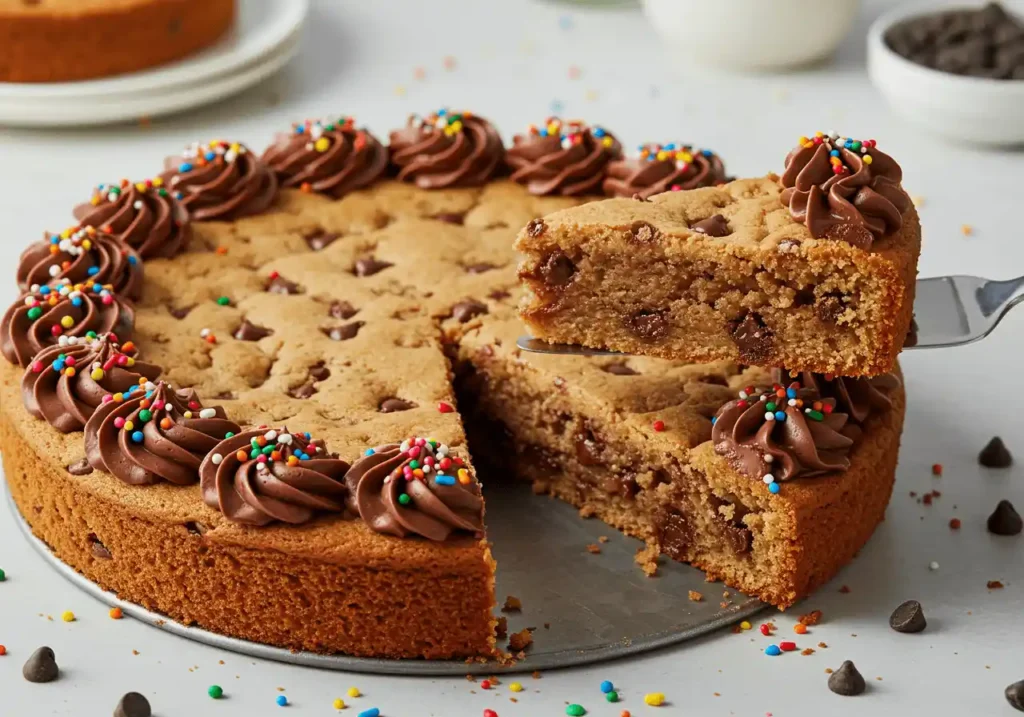
These ingredients come together in a simple dough, creating a soft center with crisp edges. Next, we’ll look at how to assemble and bake this giant cookie so that it turns out delicious every time.
Instructions
Follow this detailed process to create your cookie cake. Each step is designed to guide you through making a delicious treat with a soft, chewy center and slightly crisp edges.
Step 1: Prepare Your Workspace and Pan
- Preheat Your Oven: Set your oven to 350°F. A preheated oven ensures that the cookie cake bakes evenly.
- Prepare the Pan: Choose a 9-inch round cake pan or a springform pan. Coat the pan lightly with oil or cover it with parchment paper. This makes it easier to remove the finished cake without breaking its shape.
Step 2: Combine the Dry Ingredients
- Sift Together: In a medium bowl, sift 2 ¼ cups of all-purpose flour, 1 teaspoon of baking soda, and ½ teaspoon of salt.
- Set Aside: Keep the dry ingredients in reserve while you work on the wet mixture.
Step 3: Cream the Butter and Sugars
- Mix the Fats and Sugars: In a large bowl, place 1 cup of room-temperature unsalted butter, ½ cup granulated sugar, and ¾ cup brown sugar.
- Beat Until Light: Use a mixer to blend these ingredients until the mixture appears smooth, light, and slightly fluffy. Pause to scrape the bowl’s sides for even mixing.
Step 4: Add the Egg and Flavoring
- Incorporate the Egg: Crack one large egg (preferably at room temperature) into the butter-sugar blend.
- Stir in Vanilla: Pour in 1 teaspoon of vanilla extract. Mix thoroughly until the egg and vanilla are well combined into the batter.
Step 5: Combine the Mixtures
- Integrate Dry into Wet: Gradually add the sifted dry ingredients to the wet mixture.
- Mix Gently: Stir at a low speed until the flour is just incorporated. Stir until the ingredients just come together to ensure a tender result.
Step 6: Fold in the Chocolate Chips
- Add the Chips: Carefully fold in 1 cup of semi-sweet chocolate chips.
- Ensure Even Distribution: Use a spatula to mix the chips evenly throughout the dough, ensuring every bite has a burst of chocolate.
Step 7: Spread the Dough in the Pan
- Transfer the Dough: Pour the cookie dough into your prepared pan.
- Smooth It Out: Press the dough evenly across the surface of the pan using a spatula or your hands. A smooth, even layer helps the cake bake uniformly.
Step 8: Bake the Cookie Cake
- Baking Time: Place the pan in the oven and bake for 20 to 25 minutes.
- Check for Doneness: As baking nears the end, look for edges that turn lightly golden and a center that remains soft. When you test the center with a toothpick, it should emerge with a few damp crumbs attached.
Step 9: Cooling Process
- Rest in the Pan: Remove the cookie cake from the oven and let it sit in the pan on a wire rack for about 10 minutes.
- Cool Completely: Transfer the cake from the pan to the wire rack. Allow it to cool to room temperature. Cooling helps the structure settle and makes it easier to cut.
Step 10: Optional Decorating
- Frost or Top: If you like, spread a thin layer of your favorite frosting or dust with powdered sugar once the cookie cake has cooled.
- Add Extra Toppings: Enhance the look with extra chocolate chips, sprinkles, or candy pieces as desired.
By following these steps, you’ll achieve a cookie cake with the perfect balance of textures and flavors. This straightforward method is easy to follow, ensuring a delightful dessert that you can enjoy at any celebration.
Pro Tips and Variations
Elevate your cookie cake by experimenting with these practical tips and creative variations. These ideas will help you fine-tune the recipe and tailor it to your personal taste. Below are some strategies to ensure a consistently delightful outcome and a few creative twists to make your cookie cake uniquely yours.
Pro Tips for the Perfect Cookie Cake
- Maintain the Right Temperature:
Use room-temperature butter and eggs to ensure that the ingredients blend smoothly. This helps create a uniform dough that bakes evenly. - Gentle Mixing:
When combining the dry and wet ingredients, stir until the mixture just comes together. This minimal mixing keeps the texture soft and tender. - Even Distribution of Add-ins:
Gently fold in the chocolate chips to spread them evenly. This ensures each bite delivers the sweet surprise of chocolate. - Monitor Baking Time:
Keep a close eye on the cookie cake as it bakes. Remove it from the oven when the edges are lightly golden, even if the center appears slightly underdone. The residual heat will continue to set the cookie dough while preserving a soft center. - Cooling Is Key:
Allow the cookie cake to cool in the pan briefly, then transfer it to a wire rack. This cooling step is essential for the cake to firm up and makes it easier to slice without breaking.
Variations to Customize Your Cookie Cake
- Flavor Twists:
Mix different types of chocolate chips, such as semi-sweet and milk chocolate, to add layers of flavor. You can also incorporate white chocolate chips for an extra burst of sweetness. - Nutty Additions:
Fold in finely diced walnuts or pecans into the batter. They contribute a crunchy texture and a rich, nutty flavor that pairs well with the sweetness of the cookie cake. - Spice It Up:
Introduce a pinch of cinnamon or nutmeg into the dry ingredients. These spices add warmth and a hint of complexity to the overall flavor. - Frosting Options:
Once the cookie cake is completely cool, consider topping it with a thin layer of frosting. Chocolate ganache or classic buttercream can transform it into a dessert that is not only delicious but also visually appealing. You might also try a dusting of powdered sugar for a lighter finish. - Creative Toppings:
Enhance the presentation and flavor by adding toppings such as sprinkles, a drizzle of caramel sauce, or a scattering of sea salt just before baking. These finishing touches can create a delightful balance of sweet and savory notes. - Dietary Adaptations:
For a vegan version, substitute unsalted butter with a plant-based alternative, and replace the egg with a flax egg or another vegan binder. Gluten-free enthusiasts can opt for a quality gluten-free flour blend while maintaining the balance of ingredients. - Double Chocolate Variation:
To satisfy serious chocolate lovers, try mixing cocoa powder into the dough along with the chocolate chips. This variation creates a rich, double chocolate experience that intensifies the dessert’s flavor. - Mini Cookie Cakes:
Instead of one large cookie cake, use smaller pans to make individual portions. This variation allows you to experiment with different frostings or toppings on each mini cake, making it a fun option for parties.
These pro tips and variations offer flexibility and creative freedom. They not only ensure your cookie cake turns out perfectly every time but also invite you to experiment and add your personal twist. Enjoy testing these ideas to make your dessert truly one-of-a-kind!
Serving Suggestions
A cookie cake is a versatile dessert that can be enjoyed in many different ways. Here are some ideas to serve your cookie cake while keeping the focus on flavor and presentation:
- Classic Presentation:
Cut the cookie cake into even slices. Serve it on a plain plate to let the cookie cake’s texture and toppings shine. A light dusting of powdered sugar on top can add an elegant finish. - With Ice Cream:
Pair a warm slice of cookie cake with a scoop of vanilla or chocolate ice cream. The contrast between the soft cake and cold ice cream creates a delightful combination. - Fruit and Freshness:
Serve your cookie cake with fresh berries or sliced fruit. Strawberries, blueberries, or raspberries can add a burst of tartness that balances the sweetness. - With Beverages:
Enjoy a slice of cookie cake alongside a glass of cold milk, a cup of coffee, or a warm tea. These pairings enhance the dessert’s flavors and provide a refreshing contrast. - Frosting and Toppings Options:
For extra flair, offer a small bowl of chocolate ganache or a light drizzle of caramel sauce on the side. Guests can choose to add extra frosting or toppings as they prefer. - Party Platter:
For gatherings, arrange slices on a decorative platter. Add small bowls of toppings such as sprinkles, extra chocolate chips, or crushed nuts so everyone can customize their slice. - Mini Variations:
If you bake mini cookie cakes instead of one large cake, serve them as individual portions. Mini cookie cakes can be a fun addition to a dessert buffet or a themed celebration.
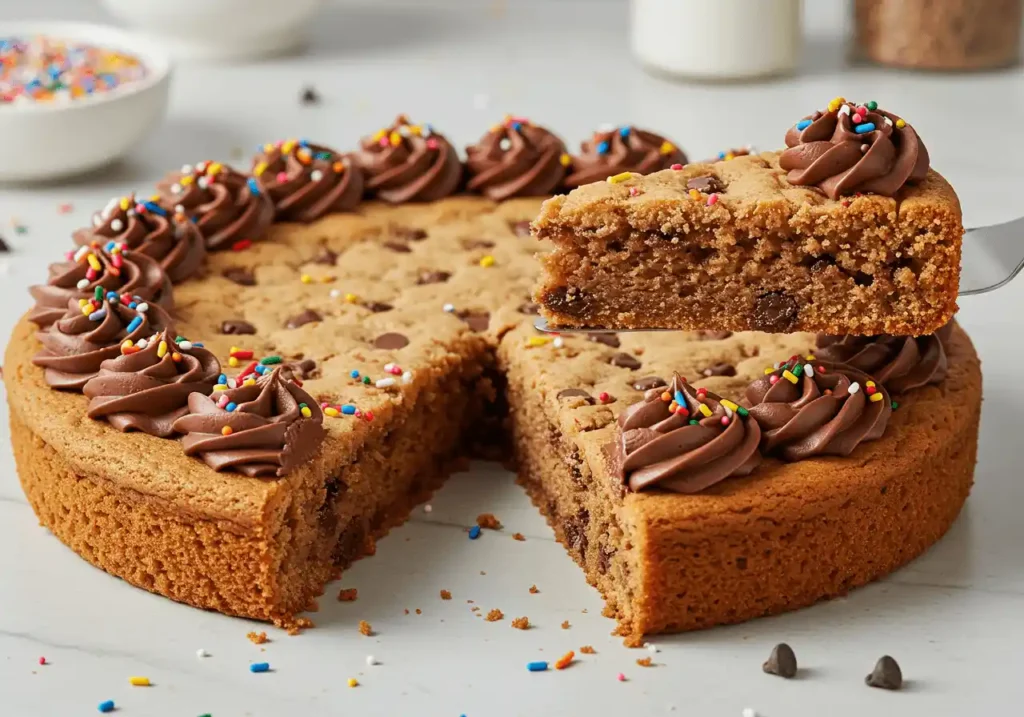
Each serving idea enhances the experience of your cookie cake. Whether you prefer a simple presentation or enjoy experimenting with toppings and pairings, these suggestions allow you to make every slice a unique treat. Enjoy your creation as a dessert at parties, a special treat for family gatherings, or just a satisfying snack any time of the day.
Conclusion
This guide has provided a clear and easy path to create a delightful cookie cake that merges the best qualities of cookies and cakes. You now have a complete overview—from gathering the ingredients and mixing the dough to baking and serving your creation. The process is straightforward, allowing you to achieve a cookie cake with a chewy center and slightly crisp edges, perfect for any celebration.
Your cookie cake is not only a fun dessert option but also a canvas for creativity. By following these instructions, you can experiment with different add-ins and toppings to match your personal taste. Whether you choose to enhance it with extra chocolate chips, a thin layer of frosting, or a sprinkle of powdered sugar, each step adds a unique touch to your final product.
Enjoy the satisfaction of preparing a dessert that feels both comforting and special. This recipe encourages you to try new variations and adapt the process to suit your style. Share your experience with friends and family, and let the joy of homemade treats brighten your gatherings. Happy baking!
FAQs
Below are some frequently asked questions to help clarify any doubts about cookie cakes, their ingredients, and the differences in textures and flavors compared to traditional cookies.
What makes a cake like a cookie?
A cake like a cookie is created by taking the classic cookie dough and baking it in a larger, cake-sized pan. This method allows the dessert to develop both cookie-like flavors and cake-like presentation. The resulting treat offers the best of both worlds—a familiar cookie taste with a soft, layered structure that is easy to serve and share. The contrast in textures, with its chewy center and crisp edges, is achieved by managing the dough’s spread and adjusting the baking time, ensuring that every slice has a balance of flavors and consistency.
Why do cookie cakes taste different?
Cookie cakes have a unique taste because the baking process in a larger pan influences both texture and flavor. The distribution of heat is different compared to standard cookies, which creates a soft, chewy center with crispier edges. Moreover, when baking a cookie cake, slight adjustments in the ingredient proportions and baking time may be made to achieve the desired consistency. This means that while the ingredients might be similar, the overall eating experience is distinct from that of traditional, smaller cookies.

